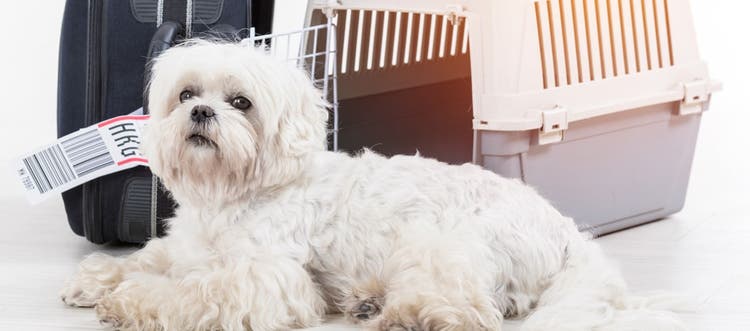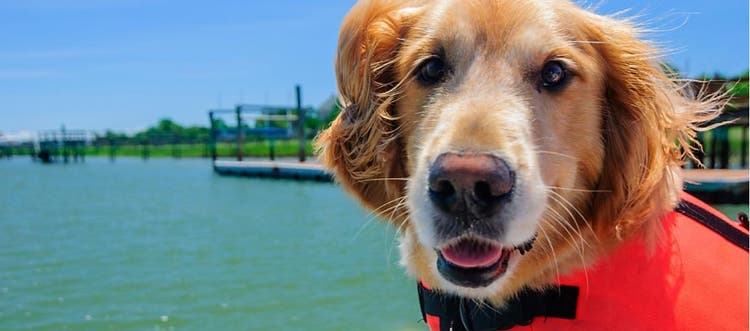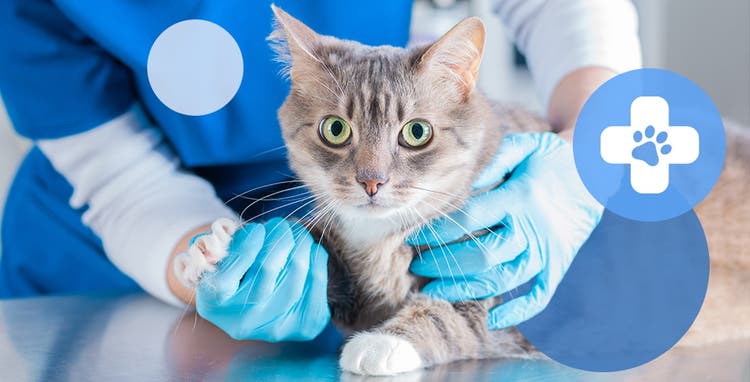Dog travel tips plus a packing checklist.
Whether you’re jet-setting to a faraway land or simply driving to the nearest beach for the day, if you have a pet it’s important to know how (or if) they fit into your next vacation plan. Here’s our guide to planning the perfect vacation with (or without) your pet.
How to Travel with a Dog
Before traveling with your dog, ask yourself, Will my dog be happy on this trip? Travel can be stressful for anyone, including our pets! If you’ve never traveled with your dog before, think about the times you’ve taken your dog someplace new. Was your dog laid back about the experience or did they show signs of anxiety? Also consider your dog’s health, the mode(s) of transportation you’ll be using, lodging and destination(s).
Planning for Traveling with a Dog
The most important thing you can do in advance of traveling with your dog is research. Start with the state or country you plan to visit and check for travel regulations. What are the rules? Some rules may be obvious, but some countries have different laws around details like microchipping and quarantining.
Next, research your mode(s) of transportation. Depending on your dog’s size, travel may be impossible. If it is possible, make sure you are comfortable with how your dog will travel and that you understand all the arrangements you will need to make in advance.
If traveling with your pet is possible, start looking into pet-friendly hotels and lodging. Search specifically for hotels that allow pets. Call the hotel or bed-and-breakfast ahead of time to confirm its pet policies before arriving.
Finally, think about the activities you’ll be doing during the day. Will you be going on a lot of hikes that your dog can join you on? If you’re visiting the ocean, is there a dog-friendly beach nearby? Or will your dog be spending most of their time inside the condo, in a crate?
Before traveling with your dog, you need to visit your veterinarian. Share the details of your travel plans, including all transportation methods and places you’ll be visiting. Your vet will likely do a full physical exam and will make sure your dog’s vaccinations are up to date. If there is an increased risk of parasites where you’re going, your vet may be able to offer prevention recommendations.
Request a copy of your dog’s health and vaccination records before you leave, and if you’re running low on a prescription food or medication, make sure you have enough for your trip. Note: Depending on your mode(s) of transportation, check with your air carrier (or cruise ship or train). Many air carriers, for example, require an updated health certificate within 10 days of travel, which means you’ll need to schedule your vet appointment accordingly.
What Do I Need to Travel with My Dog?
- Leash and collar: Identification tags on the collar should include your name and phone number, your dog’s name and proof of rabies shots.
- Current photo: This can be helpful if your dog gets lost.
- Copy of health and vaccination records: Various places along your trip may require this.
- Crate: Think planes, trains and automobiles — no matter what mode of transportation you’ll be using, make sure your crate adheres to rules and regulations and is labeled appropriately. Consider lodging, too, if your dog will be spending time in a crate where you’ll be staying. Be sure to check that any facilities you bring your dog to are pet safe and pet friendly.
- Dog seatbelt, harness or car seat: This can help keep your dog safe if you’re driving.
- Water and bowl: Consider buying a collapsible bowl. Bottled or gallon jugs of water may reduce the chances of an upset stomach.
- Food and bowl: Make sure you have enough food to last the entire trip, especially if it’s prescription food or a specialty diet. A collapsible bowl can be helpful as well.
- Medicine: If your dog takes daily prescription medicine, make sure to pack enough for the trip, plus some extra. Also be mindful of when your dog is due for their next preventive. It’s important to stay on track of, for example, heartworm preventives, especially if you’ll be gone for a while. Be sure to store all medication as directed when traveling.
- Life vest: If you’re going to be boating or swimming with your dog, bring a life vest that fits properly.
- Treats: Traveling can be stressful, but treats can help — just be sure to wait until you get to your destination. The stress and anxiety of travel can exacerbate an upset stomach.
- Bed: If you’re traveling by car and have room, consider bringing your dog’s bed so they can enjoy a bit of home away from home.
- Toys: Just like a child loves their favorite doll or teddy bear, your dog will be grateful you packed some loved toys (maybe avoid the squeaky ones in the car).
Flying with a Dog
Flying with a dog is doable, but it takes advance planning. According to the U.S. Department of Transportation, federal and state governments have restrictions on transporting live animals, and every airline has its own policies as well — so it’s up to you to research these restrictions and policies.
Where to start? This overview from the U.S. Department of Transportation provides some up-to-date general tips, as well as requirements mandated by the federal Animal Welfare Act. You also need to contact your air carrier to fully understand its policies before solidifying any travel plans.
Taking your dog overseas is tricky. The U.S. Department of Agriculture provides up-to-date, detailed guidance. Additionally, the U.S. Department of Agriculture has additional restrictions for bringing dogs back into the U.S. after traveling internationally.
Driving with a Dog
Just like you wear a seatbelt, your dog needs to use a seat belt, harness, car seat or crate in a car. If you use a crate, make sure it’s the right size. Your dog should be able to comfortably stand, sit and lie down in it. Make sure you have enough room in your vehicle for the crate to be placed on a flat surface. Follow all instructions for safe travel that your crate provides.
Although you may be itching to get to your destination, it’s important that you take frequent breaks when driving with a dog. Not only will this give your dog a chance to relieve themselves, they can drink some water (bring your own to avoid digestive issues) and walk around a bit, too.
Tips for Leaving a Dog with Someone Else While You Travel
If you decide it’s best to leave your dog at home while you travel, you have several options.
- Family member or friend: Your dog may be familiar with this person, which can make the experience less stressful. However, dog sitting can be a lot. Consider who to ask: Do you have a family member or friend that thoroughly enjoys your dog or has a dog that you sit for in return? Also, think about any pets that might be in the pet sitter’s home (will your dog get along with them?) and anyone who may be allergic.
- Dog sitter: One of the best ways to find a good dog sitter is through referrals from family members or friends. You can also ask your veterinarian for recommendations. Dog sitters may come and go multiple times a day, or, more often, they may live at your house while you’re on vacation. This way they’re able to let your dog out as needed and provide plenty of play time. Make sure your dog sitter is well vetted. There are several national organizations your dog sitter may be affiliated with, including Pet Sitters International and the National Association of Professional Pet Sitters.
- Boarding: Many dog owners board their dogs when they travel. However, if you’ve never boarded your dog before, you need to do some advance planning. To find a reputable place, ask friends and family members for referrals or contact your veterinarian. Take a tour of the kennel or the person’s home to make sure everything looks secure, clean, climate controlled and safe. Most kennels require immunizations, including Bordetella, rabies, distemper, hepatitis, parvovirus and parainfluenza shots. Some kennels also require a trial run — sometimes a few hours, a day or 24 hours while you’re in town. Some dogs do better than others in a kennel, so a trial run helps the owner and dog feel more comfortable.
Some of your most memorable vacations can be those spent with your dog. Sometimes the kindest thing you can do is leave your dog at home. Only you know which option is best.









